Oleg Novitsky
Oleg Viktorovich Novitskiy (Russian: Олег Викторович Новицкий; born October 12, 1971 in Červień, Belarus), lieutenant colonel in the Russian Air Force, is a Russian cosmonaut.
Oleg Viktorovich Novitskiy | |
|---|---|
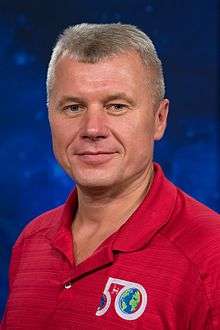 | |
| Born | October 12, 1971 |
| Status | Active |
| Nationality | Russian |
| Awards | Hero of the Russian Federation |
| Space career | |
| RKA Cosmonaut | |
| Rank | Lieutenant-Colonel, Russian Air Force |
Time in space | 340 days 10 hours 4 minutes |
| Selection | 2006 TsPK-14 Cosmonaut Group |
| Missions | Soyuz TMA-06M (Expedition 33/34), Soyuz MS-03 (Expedition 50/51) |
Mission insignia |  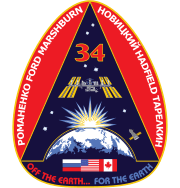 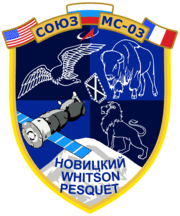 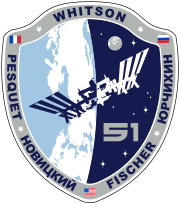 |
Biography
Novitskiy was born on October 12, 1971, in Cherven, a Belarusian town of Minsk Region. Graduated from school#2 in Cherven in 1988 and entered the Borisoglebsk Military Pilot School named after V. Chkalov.
In 1994 he graduated from the Kachinskoye Military Pilot School named after A. Myasnikov, where he studied at the department specializing in command tactical aviation. Novitskiy was certified as a pilot-engineer. Between September to December 1995, Novitskiy served as a pilot-instructor in the fighter aviation regiment of V. Chkalov Training Center. From December 1995 to June 2004 he served in a variety of positions, from pilot to air squadron deputy commander at the fighter air regiment of the 1st Guard Composite Air Division of the 4th Air Army and Air Defense Army of the North Caucasus Military Command.
Graduated in 2006 from the Yuri Gagarin Air Force Academy specializing in military units/Air Force detachments management.[1] After graduation from the Academy Novitskiy was a commander of an attack air squadron. By the time of selection to the Cosmonaut Corps he has mastered skills of piloting the Л-39 and Су-25 aircraft. He has logged a total of 700 hours of flight time. He is a Class 2 military pilot. Novitskiy is a qualified paratrooper instructor and military diver.[1]
Spaceflight Experience
Novitskiy was selected as a cosmonaut in 2006.Between February 2007 to July 2009 he completed basic spaceflight training and passed state exams with excellent grades. On August 1, 2009, he was qualified as a test-cosmonaut by the Interdepartmental Qualification Board, and between August 2009 to March 2010 he took the ISS advanced training course.
Expedition 33/34
From March 2010 to May 2012 he trained as the ISS Expedition 31/32 backup crew member, the Soyuz TMA-M Commander/ISS Flight Engineer.
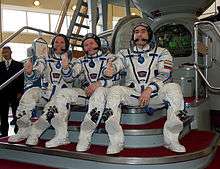
Part of Expedition 33/34 to the international space station where he served as ISS flight engineer. He was launched to space as part of the Soyuz TMA-06M crew on October 23, 2012 and returned on March 16, 2013. Overall time in space was 143 days 16 hours and 15 minutes.

Expedition 50/51
Novitskiy returned to space as part of Expedition 50/Expedition 51 which launched on November 17, 2016 on Soyuz MS-03.

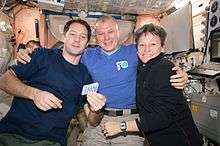
On June 2, 2017, MS-03 undocked from the ISS, carrying Novitskiy and Thomas Pesquet back to Earth after 196 days in space. Peggy Whitson will remain on the ISS and return on Soyuz MS-04. MS-03 touched down just over 3 hours after undocking, concluding Novitskiy's second spaceflight
Honors and awards
Ministry of Defense of Russian Federation medals:[1]
- “For Participation in Military Operations”
- “For Military Virtue”, II degree
- “For Distinguished Military Service”, I, II and III degree
- “For Service in the Air Force”.
- Veteran of Military Operations
References
- "OLEG VIKTOROVICH NOVITSKIY". NASA. July 2012. Retrieved 18 November 2016.
External links
![]()